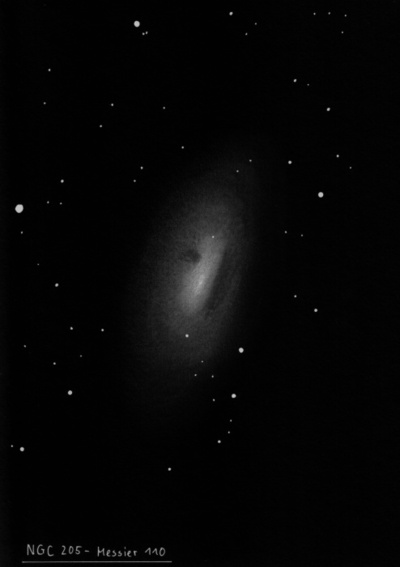
Caroline Herschel discovered M110 = M110 = H V-18 = h44 on 27 Aug 1783. In the 1785 Philosophical Transactions, William wrote "there is a very considerable, broad, pretty faint, small nebula near it; my sister discovered it, August 27th, 1783, with a Newtonian two-feet sweeper." Charles Messier probably made an earlier observation on 10 Aug 1773, though no report was published, nor does it appear in his notes. A sketch published in 1807, though, showed both companions to M31. Kenneth Glynn Jones suggested adding NGC 205 as M110 in a 1967 Sky & Telescope article. William Herschel first observed it on 5 Oct 1784 (sweep 282). On 17 Oct 1786 (sweep 613), he recorded "vB, mE, above 20' long nearly in the meridian; a few degrees from np to sf, the branches lose themselves." On 24 Oct 1786 (sweep 621), he also logged "eB, mE. I suppose not less than 1/2° long and 10 or 12' broad.; vgmbM; so as to come to a luminous nucleus. The time very inaccurate, the telescope being off the roller, and only guided by hand."
M110 was observed with Lord Rosse's 72" on 2 Nov 1850 and "spirality" was suspected (falsely). A later observation on 16 Oct 1855 recorded "vL; mE np by sf; sharp nucleus, for some distance round which, the neb. is bright and then suddenly decreases; there is a bright star np the nucleus; and another involved in sf end; another in preceding border.”
200/250mm - 8" (10/4/80): fairly bright, large, elongated ~N-S, companion to M31.
300/350mm - 13.1" bright, very large, elongated 5:2 NNW-SSE, 10'x4', quite prominent but only a gentle broad concentration. G73, the brightest globular cluster in M110 (or associated with M31), lies 6' E of center and appears as a 15th magnitude "star".
Notes by Steve Gottlieb